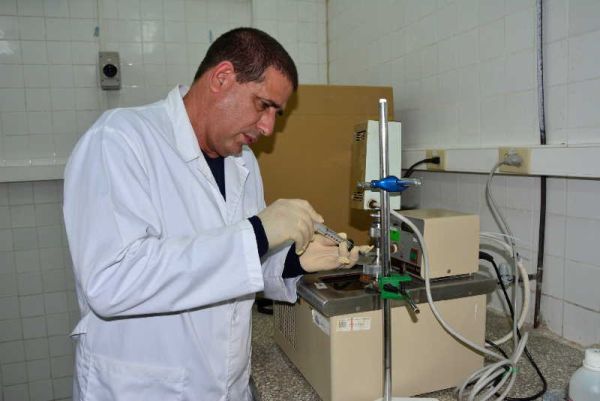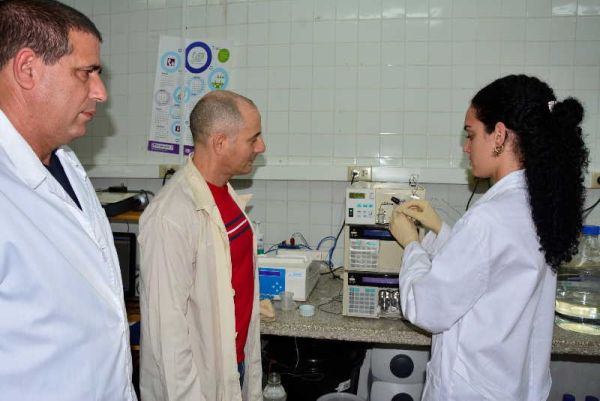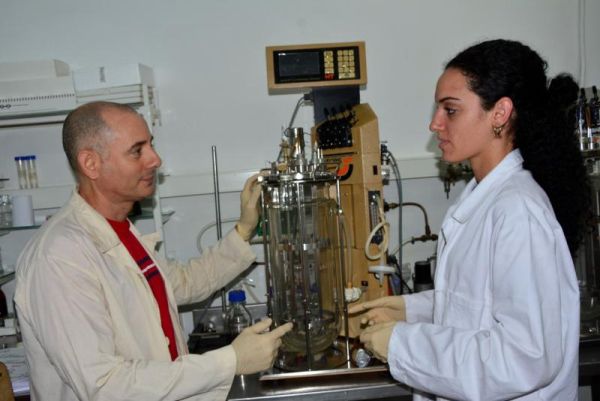
of the remarkable scientific result. (Photo: Vicente Brito / Escambray).
A multidisciplinary team of scientists, led by an engineer from Sancti Spiritus, central Cuba, has developed some industrial product with its corresponding intellectual property which has been already patented in the United States, Australia, Eurasia and South Africa, among other regions.
The whole story began in 2002, when a group of researchers from both the Centers of Genetic Engineering and Biotechnology (CIGB) of Havana and Sancti Spíritus started a joint project where molecular biology and technological development were integrated to obtain, by means of a recombinant method, a vegetal-origin enzyme that transforms sucrose into fructooligosaccharides (FOS).
Trying to translate this word is certainly risky. The FOS are prebiotic and sweeten elements with a growing demand in the formulation of functional and nutraceutical food, but in great need of simple processes that reduce their production costs and expand their application.
“We are talking about a syrup that is produced out of sugar and after a previous biotechnological process. We first obtained an enzyme in the laboratories from which an industrial production was made. Imagine a solution of water with sugar to which that enzyme is added that transforms sucrose into FOS. Afterwards, a process of purification and concentration is carried out to make it suitable for human consumption in the form of functional or nutraceutical food, which will be beneficial for health”, said the chemical engineer and doctor of science Enrique Rosendo Pérez Cruz.

Are we talking about a medicine or a food item? Which is its practical usefulness?
“It is a functional food, a prebiotic element, about which there is enough scientific evidence. The FOS keep the main chemical and organoleptic properties of sugar but, unlike it, they are not cariogenic and are not digested by the enzymes present in the upper part of the gastrointestinal tract of humans and other monogastric animals, so they have a hypocaloric character. When they reach the large intestine, they are selectively used as a carbon sources, thus decreasing the populations of pathogenic bacteria.
“The improvement of the intestinal microflora resulting from the ingestion of FOS leads to secondary health benefits such as the control of diarrheas, high blood pressure and diabetes, the reduction of toxic and rotten substances in the large intestine, the prevention of colon cancer, the reduction of cholesterol levels in blood, the absorption of minerals and the modulation of immune system functions, among others. Benefits are also reported in animals. Nowadays, it is the tendency to eat foods that have these additional characteristics”.
But the FOS already existed in the world, so, what’s new in the Cuban contribution?
“The FOS first appeared in the 90s or so. The Cuban product meets the FAO prebiotic criterion. Regulatory authorities from the United States, the European Union, Japan and China have approved their use and have labeled them in various commercial products such as functional foods (yogurt, ice cream, juices, chocolates, cakes, etc.) and nutraceuticals (infant formulas, sugars for diabetics, among others). The new of the Cuban product relies on the fact that today the FOS are manufactured out of enzymes obtained from fungi while we use an enzyme of vegetable origin expressed by a recombinant way in a yeast. On the other hand, the patent highlights the composition of the products we obtain, where 1-kestose predominates, which is the component with the lowest degree of polymerization, with the greatest prebiotic effect, the greatest sweetening power and, therefore, of greatest therapeutic and commercial interest”.
And scientifically speaking, which is the most transcendent aspect, the products obtained —the enzyme and the FOS— or the patent granted?
“The important thing is that the academic result was possible here. Cuba does not use the FOS because of their price in the market. When we started the project, world production did not exceed 9,000 tons. Today the production is around 50 000 tons and there is a growing consumption trend. We patented both, the procedure to obtain the enzyme and the product of such enzyme.
“The ton of FOS syrup costs around 3 000 dollars, and between and 7 000 and 8 000 if it has been purified. We don’t use it in Cuba, nor was it a priority, but now we have the possibility of converting a ton of solid sugar into a ton of FOS 55 syrup and this way the value of the ton of sugar is revalued almost five times for a product with a superior added value.
“Last year, 6.28 tons were produced. This is a concrete result out of the integration of science. The CIGB, the Instituto Cubano de Investigaciones de los Derivados de la Caña de Azúcar (Icidca) (Cuban Research Institute of the Sugar Cane Derivatives (Icidca)) and the Azcuba’s UEB Ignacio Agramonte of Camagüey were involved”.
What is the practical implication for Cuba with this patent?
“Having a patent gives an intangible recognition of this technology. This takes years to be materialized. The patent protects the production procedure of the enzyme, as well as its use in the manufacture of fructooligosaccharides, specifically 1-kestose, which is the product of greatest commercial interest among the FOS. In order to make use of this technology you are supposed to pay. In addition, the fact that the patent was also granted in Australia and the United States, two First World countries, opens the opportunity for other nations to do the same”.
How has the FOS syrup been used so far?
“Today its use is being promoted in Cuban companies that produce food. Since this syrup already has a sanitary registration, it is suitable for human consumption. This year a group of trials, formulations and applications of FOS must be triggered. Clinical introduction protocols might be developed for their future recommendation on patients suffering from gastrointestinal disorders. It is used that way around the world.
How much satisfaction does the main author feel for such a remarkable result?
“I always say that I am the son of the cook of a pig-raising farm and the plumber of the local pigs’ enterprise, so, for me, pigs were closer than a scientific contribution. During the first years of the project there were adverse moments because expectations were not met, and we even thought of closing it down. Luck changed when we retook some abandoned cells and made new trials that showed discreetly interesting results. From there, calculations were hopeful and the idea was developed in a different way.
“Some years later I went to Spain for my PhD thesis. When I showed the paper to the Spanish professor he immediately replied: ‘What you have is a patent for sure’. Personally I feel a double satisfaction because an engineer rarely follows a process from the laboratory to the industry. Life has rewarded me”.

 Escambray ENGLISH EDITION
Escambray ENGLISH EDITION





Escambray reserves the right to publish comments.